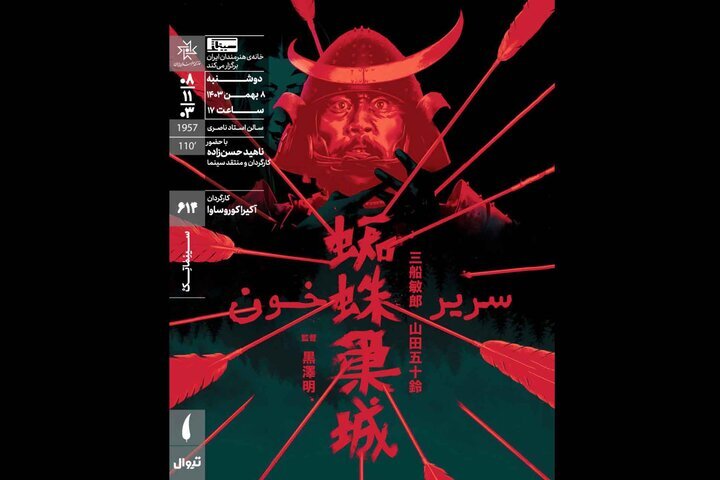IAF to show Kurosawa’s “Throne of Blood”

TEHRAN-The Iranian Artists Forum (IAF) in Tehran will screen the 1957 Japanese film “Throne of Blood” co-written, produced, edited, and directed by Akira Kurosawa on Monday.
Set for screening at 5 p.m. at the Nasseri Hall, the film will be reviewed in a session in the presence of director and film critic Nahid Hassanzadeh, Mehr reported.
The film transposes the plot of English dramatist William Shakespeare's play “Macbeth” (1606) from Medieval Scotland to feudal Japan, with stylistic elements drawn from Noh drama. The film stars Toshiro Mifune and Isuzu Yamada in the lead roles, modelled on the characters Macbeth and Lady Macbeth.
As with the play, the film tells the story of a warrior who assassinates his sovereign at the urging of his ambitious wife. Kurosawa was a fan of the play and intended to make his own adaptation for several years, delaying it after learning of Orson Welles' “Macbeth” (1948). Among his changes was the ending, which required archers to shoot arrows around Mifune. The film was shot around Mount Fuji and Izu Peninsula. With a budget of US$350,000, the film was one of the most expensive films ever made in Japan at the time of its release.
Despite the change in setting and language and numerous creative liberties, “Throne of Blood” is often considered one of the best film adaptations of the classic play, and has received much critical praise. The film won two Mainichi Film Awards, including Best Actor for Toshiro Mifune.
Akira Kurosawa (1910-1998) was a Japanese filmmaker who created 30 films of his own as well as occasionally directing and writing for others in a career spanning seven decades. He is widely regarded as one of the greatest and most influential filmmakers in the history of cinema. Kurosawa displayed a bold, dynamic style strongly influenced by Western cinema yet distinct from it. He was involved with all aspects of film production.
Kurosawa’s highly regarded films include “Rashomon” (1950), “Ikiru” (1952), “Seven Samurai” (1954), “The Hidden Fortress” (1958), “Yojimbo” (1961), “High and Low” (1963), “Red Beard” (1965), “Kagemusha” (1980), and “Ran” (1985).
In 1990, he accepted the Academy Award for Lifetime Achievement. Posthumously, he was named “Asian of the Century” in the “Arts, Literature, and Culture” category by AsianWeek magazine and CNN, cited there as being among the five people who most prominently contributed to the improvement of Asia in the 20th century.
SS/
Leave a Comment